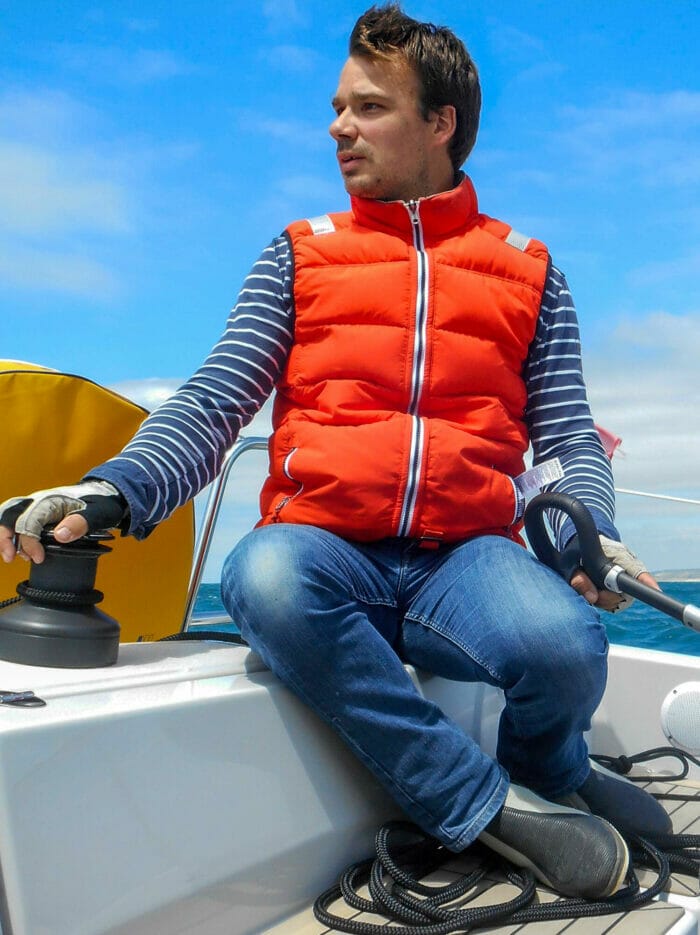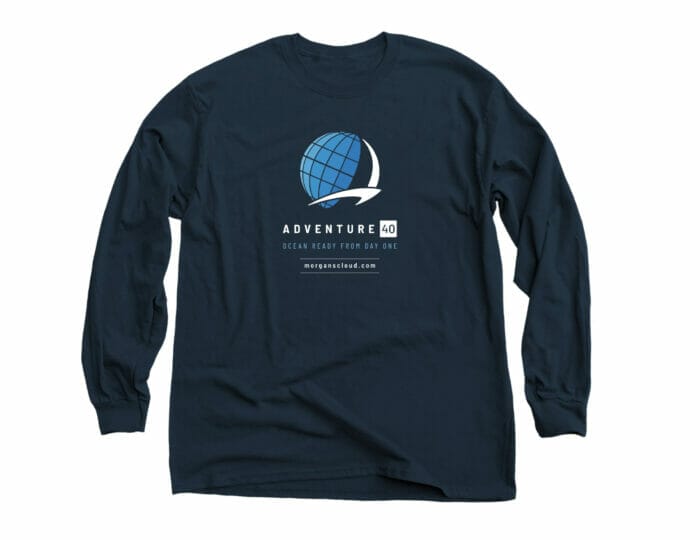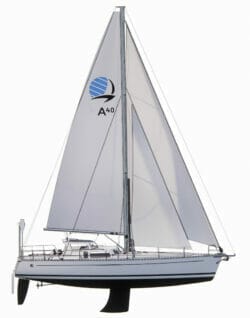
We promised exciting A40 news in November, and here it is:
Pascal and Maxime, the French partners who are making the Adventure 40 real, have selected Vincent Lebailly to design the boat.
This decision is the result of months of work, as summed up by Pascal and Maxime:
In France, the yachting industry relies on several dozen highly competent architects. We listed more than 20 architects that could meet our needs. A dozen of them showed interest in the Adventure 40 project.
After numerous long telephone conversations and meetings, our shortlist was gradually reduced. We had to make some difficult choices because the motivation and skills of the very last ones were extremely high. In the end, a list of objective criteria gave Vincent Lebailly the edge.
The important takeaway from the above is that these days much, maybe most, of the world’s offshore sailboat design is happening in France, so if a designer can compete with, and rise to the top of, that deep pool of talent he or she must be good at what they do.
The A40 partners go on to say:
To make our choice, we considered that desire and commitment to the project were the first criteria. Indeed, the Adventure 40 is not a boat like any other, it cannot be the result of a simple adaptation of an existing boat.
The needs expressed by AAC are extremely precise. Some architects perceived the A40 as a vintage boat, and didn’t see that, while using proven principles, the approach is truly modern. We needed an architect who really understands this need.
Here the takeaway is that some of the architects that the partners interviewed disparaged the Adventure 40 as vintage, but Vincent understood that in fact the boat is futuristic, in that she will bring offshore voyaging to more people in a safe and above all reliable and comfortable way, while still being fast, and at an amazingly low 10-year cost of ownership—about as far from a throwback as it’s possible to be.
I have already seen direct evidence that Vincent totally gets the Adventure 40 ethos in the form of two papers that he and the two partners have prepared, one on the rudder and the other on the rig, that improve both, but without violating the fundamental of ocean-ready reliability that is the core of the Adventure 40 concept.
I will be writing more about these changes in the next article.
But I can say right now that the suggestions made in both papers simplify the boat while making her more functional. Totally in keeping with the quote Maxime and Pascal have placed on the first page of the specification:
Il semble que la perfection soit atteinte, non quand il
n’y a plus rien à ajouter, mais quand il n’y a plus rien à retrancher.…perfection is finally attained not when there is no longer anything to add, but when there is no longer anything to take away…
Antoine de Saint-Exupéry
With this announcement, some of us may be concerned that instead of one of the great grey-beards of boat design in North America, like say Bob Perry, we have a young French designer with a bunch of high-performance modern boats to his name.
That kind of thinking, while understandable, is a huge mistake. The fact is that today pretty much everything that is exciting and innovative in offshore sailing is happening in Europe and centred on France, so by selecting a designer who will adhere to the basic concepts of the boat, but add French innovation and flair to the design, we will massively expand the market for the boat.
And this in turn will give us the sales numbers we need to achieve the quality and price goals we have set.

I also suspect that many may worry that none of Vincent’s designs look like the Adventure 40.
Not to worry, as we have discussed before, for an experienced designer like Vincent who is properly qualified, including a BEng from Southampton (now Solent) University, one of the most respected yacht naval architecture schools in the world, there is nothing technically difficult about designing the Adventure 40 to meet the specification.
And, best of all, Vincent’s track record of designing boats for the major French builders, including Garcia, will give the project credibility—to make this work a boatbuilder must believe in and know they can work with the designer.
It’s also great to see that Vincent is backed by a team, including a qualified engineer. This is a professional outfit that owners and builders have trusted for over 10 years to design millions of Euros worth of boats—we needed credibility, we got credibility.
Coming Next
In the next article I will be dissecting the rudder and rig changes and then we will move on to analyzing and discussing the full specification.
Sign Up For an Adventure 40




Thank you for the update. Nice to see this project moving along with the efforts of Pascal and Maxime.
Congratulations; this is a major milestone. The very best of best wishes for the project!
Love the pullman berths, chain lockers by the mast from his other designs. I also see transom hung rudders, short sprits to keep moving in light air and not motor. Really liking where this is going!
Hi John,
Very perceptive. I can share that there is now a sprit in the latest A40 specification.
Does that mean cutter too? 🙄
As John will watch over the spec, and it should be ocean going, I don’t see any way the A40 would be anything else than a cutter 😉
This is great news and a BIG step forward.
I like the quote from Saint-Exupéry which sums up the ethos of many aviators like him. Flight, like sailing, is not very forgiving of mechanical failure or human error, so it is absolutely appropriate to be applied to a sailboat design, especially one promoted as an expedition sailboat.
While Saint-Exupery’s statement is concise, Buckminster Fuller’s is more so;
“As complex as necessary. As simple as possible”.
This 8-word mantra is what I repeat to myself whenever I’m engaged in problem solving. It’s brevity helps concentrate the mind. Maybe it’ll help your A40 team as well.
Good luck and fair winds to this exciting project!
Hi Robert,
Another good quote.
Great. A rare translation where English takes almost more words than in French!
Bravo Pascal, Maxime, John and company…
The legend says that when a replica of the frigate that brought Lafayette to America, the “Hermione”, was started in France in the late 90’s, original plans were lacking. It turns out the British Admiralty had extensive details, scantlings and plans on this frigate. They had developed them after capturing a sistership to Hermione. These frigates were the fastest in their time and the British were literally “killing” to know the secret of their speed.
So, yes, naval architecture in France has a track record in innovation and performance that goes a long way back. The Adventure 40 design is in good hands.
Hi Pierre,
Absolutely. I’m a big reader of books about the Napoleonic Wars and many of those make clear that the ships that were often most desired by captains and crews in the Royal (British) Navy were those prizes that had been designed and built in France. And, as you say, by late in the 1800s the Navy Board was basing a lot of their designs on French ships.
OK, I’ve now gone from being excited about how the Adventure 40 would work out, to being *very* excited.
Vincent Lebailly and his team are a perfect choice here. Looking through Vincent’s design portfolio, what I see is an NA who’s backed by a strong and experienced team, and who understands how to design according to the mission requirements.
This isn’t a designer who’s going to let his ego lead the way. This isn’t a designer who draws the same boat over and over, with a few little changes to size and details, regardless of the mission. Every Lebailly boat appears to be the product of an exhaustive analysis of every aspect of the vessel’s purpose and intended use, with the design evolving to suit those requirements. They show creativity, and well-reasoned analysis, and meticulous detailing, in equal measure.
For a couple of years, I toyed around with the idea of doing the A40 design myself. But I’m not the right person for the job. Vincent is. And it’s going to be awesome.
Hi Matt,
I came to just about the same conclusion, but it’s great to have that confirmed by someone who has formal training and has actually designed boats.
Thank you Bill, Kit, John, Robert, Philippe, Pierre and Matt for the kind words!
To us, encountering Vincent was a great pleasure and joy. We’re very happy to see that you second our choice!
I may have to update my cruising budget!
I have enjoyed following the Adventure 40 and dreaming… Recently I happened onto a shallow draft aluminum french built boat of 40′ called Allures 40.9, which I liked, but I realized how different different they must be, in ways I don’t realize. I am wondering if anyone knows more about these boats and how they would differ.
Hi Frederick,
The Allures is an interesting boat, but my big objection to them has always been the fibreglass deck. To me it makes no sense to build an aluminium boat and then introduce an 100 foot joint between two materials with radically different characteristics. One of the great advantages that aluminium boats have over glass is they are far less prone to deck leaks, so that advantage goes away with the Allures.
I also don’t like twin rudders, particularly for cruising, way too vulnerable and gets you into a bow thruster: https://www.morganscloud.com/2017/11/16/qa-coming-alongside-docking-with-twin-rudders/
So, if I were going to spend that kind of money and wanted an aluminium lifting keel boat I would look at a Boreal, Ovni, or older Garcia. More on two of those options here: https://www.morganscloud.com/category/boat-design-selection/
As to the Adventure 40 compared to the Allures, or the others I mention above, they are completely different types of boats, so hard to compare without a full article, but if you read through the entire A40 online book, and then follow the links above and dig in, you should get a good feel for which boat will suite you best.
I realise you have a ways to go but I’m not getting any younger. Care to take a guess on when you will have one for a demo sail? It sounds like a wonderful boat and project.
Hi Jack,
If I had to guess, I would say 18 months. That said there are a huge number of variables in play that could change that.
Thanks John